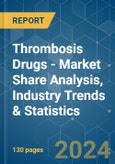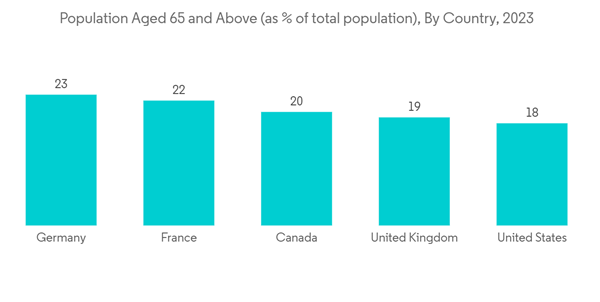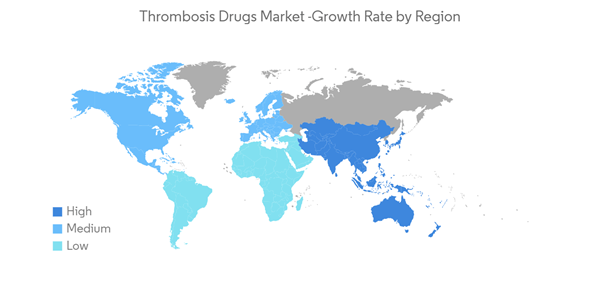The thrombosis drugs market is expected to register a CAGR of about 9.0% over the forecast period.
The COVID-19 pandemic had a significant impact on the studied market growth. For instance, according to the World Health Organization, 2021, services for cardiovascular crises have been interrupted partially or entirely in more than half of the nations examined during the early pandemic. Furthermore, according to the study published in the British Medical Journal in December 2021, in individuals with COVID-19, antiplatelet therapy (APT) may help reduce mortality; a randomized experiment (RECOVERY) found that aspirin therapy is linked to a 1.2% absolute gain in survival. Thus, the COVID-19 outbreak affected the market's growth significantly; however, as the pandemic has currently subsided, the market is expected to experience pre-pandemic growth levels during the study's forecast period.
The market is primarily driven by the increase in the geriatric and obese population, the rising burden of cardiovascular diseases and trauma cases, and the technological advancement in haematology. For instance, according to the United Nations World Population Prospects 2022, the share of the global population aged 65 years or above is projected to rise from 10 per cent in the current year to 16 per cent in 27 years. The source also stated that by 2050, the number of persons aged 65 years or over worldwide is projected to be more than twice the number of children under age five and about the same as that of children under age 12. Since the older population is prone to the disease, it is expected to generate the need for these drugs for treatment, thereby driving the market's growth.
Additionally, the increasing burden of obesity has also changed significantly in the last decade globally. Developed and emerging markets are having significant issues controlling the associated diseases. The growing consumption of alcohol and tobacco, with overweight and obesity, adds a high risk of developing significant blood pressure in veins for a long period of life, leading to several thrombosis-related complications, thus driving this market. For instance, according to the World Health Organization Report of March 2022, globally, over 1 billion individuals, including 650 million adults, 340 million teenagers, and 39 million children, were obese in 2022. Additionally, 167 million adults and children are expected to have worse health in two years due to being overweight or obese. Thus, with the increase in the obese population, the demand for thrombotic drugs is expected to increase over the forecast period as obesity is a significant cause of vascular diseases. Other factors contributing to the growth of this market are increasing the burden of cardiovascular and trauma cases, and the increasing research and development expenditure in the field of hematological disorders.
However, a lack of awareness about venous thromboembolism conditions and the side effect associated with thrombosis drugs may restrain the market growth over the forecast period.
According to a study published in the National Library of Medicine in August 2021, the prevalence of DVT in lower limbs is 1 per 1000 persons every year, with an annual incidence of DVT predicted to be 80 cases per 100,000 people. Additionally, per the same source, more than 200,000 people in the United States experience venous thrombosis yearly; 50,000 of these instances are exacerbated by pulmonary embolism. Thus, the growing prevalence of deep vein thrombosis is expected to drive segment growth over the forecast period.
Furthermore, the market players are focusing on introducing innovative products, further adding to the market growth. For instance, in June 2021, the United States Food and Drug Administration approved Pradaxa (dabigatran etexilate) oral pellets to treat deep vein thrombosis (DVT) and pulmonary embolism (PE) in children aged three months to under twelve. Moreover, DVT is often associated with old age, which is also expected to enhance the segment growth.
Thus, all factors above, such as the high prevalence of DVT and increasing product launches, are expected to boost the market growth over the forecast period.
For instance, as per the data updated by the Trust for America's Health (TFAH) in September 2022, an estimated 19 states in the United States had obesity rates over 35% in 2022, which increased from 16 states in 2021. This is likely to impact the market growth in the region positively.
Additionally, a growing geriatric population that is more prone to cardiovascular diseases is expected to boost market growth. For instance, according to America's Health Rankings Senior Report published in 2021, the number of older adults living in the United States is significant and growing. Itt is anticipated that there will be 85.7 million adults in the country who are 65 years or older, in 27 years. Such a high disease prevalence, along with the aging population, is likely to increase the demand for advanced therapies, thereby contributing to market growth.
Moreover, according to the data updated by the Canadian Institute for Health Information in July 2022, it was estimated that about 2.4 million Canadians had heart disease in the current year. Thus, with the increasing burden of cardiovascular diseases across the country, the studied market is expected to witness strong growth, as it would lead to increased usage of thrombosis drugs for treatment.
Thus, all aforementioned factors such as the high prevalence of cardiovascular diseases and the growing geriatric population are expected to boost the market growth over the forecast period.
This product will be delivered within 2 business days.
The COVID-19 pandemic had a significant impact on the studied market growth. For instance, according to the World Health Organization, 2021, services for cardiovascular crises have been interrupted partially or entirely in more than half of the nations examined during the early pandemic. Furthermore, according to the study published in the British Medical Journal in December 2021, in individuals with COVID-19, antiplatelet therapy (APT) may help reduce mortality; a randomized experiment (RECOVERY) found that aspirin therapy is linked to a 1.2% absolute gain in survival. Thus, the COVID-19 outbreak affected the market's growth significantly; however, as the pandemic has currently subsided, the market is expected to experience pre-pandemic growth levels during the study's forecast period.
The market is primarily driven by the increase in the geriatric and obese population, the rising burden of cardiovascular diseases and trauma cases, and the technological advancement in haematology. For instance, according to the United Nations World Population Prospects 2022, the share of the global population aged 65 years or above is projected to rise from 10 per cent in the current year to 16 per cent in 27 years. The source also stated that by 2050, the number of persons aged 65 years or over worldwide is projected to be more than twice the number of children under age five and about the same as that of children under age 12. Since the older population is prone to the disease, it is expected to generate the need for these drugs for treatment, thereby driving the market's growth.
Additionally, the increasing burden of obesity has also changed significantly in the last decade globally. Developed and emerging markets are having significant issues controlling the associated diseases. The growing consumption of alcohol and tobacco, with overweight and obesity, adds a high risk of developing significant blood pressure in veins for a long period of life, leading to several thrombosis-related complications, thus driving this market. For instance, according to the World Health Organization Report of March 2022, globally, over 1 billion individuals, including 650 million adults, 340 million teenagers, and 39 million children, were obese in 2022. Additionally, 167 million adults and children are expected to have worse health in two years due to being overweight or obese. Thus, with the increase in the obese population, the demand for thrombotic drugs is expected to increase over the forecast period as obesity is a significant cause of vascular diseases. Other factors contributing to the growth of this market are increasing the burden of cardiovascular and trauma cases, and the increasing research and development expenditure in the field of hematological disorders.
However, a lack of awareness about venous thromboembolism conditions and the side effect associated with thrombosis drugs may restrain the market growth over the forecast period.
Thrombosis Drugs Market Trends
Deep Vein Thrombosis (DVT) Segment is Expected to Register a Significant Growth during the Forecast Period
Deep vein thrombosis (DVT) is a blood clot in one of the large, deep veins that returns blood from the leg and rarely in the arm or heart. The Segment growth is driven by the increasing prevalence of chronic deep vein thrombosis and product launches by the key market players. In addition, increasing focus on developing low-cost drugs and a large patient pool contribute to the growth of the thrombosis drugs market.According to a study published in the National Library of Medicine in August 2021, the prevalence of DVT in lower limbs is 1 per 1000 persons every year, with an annual incidence of DVT predicted to be 80 cases per 100,000 people. Additionally, per the same source, more than 200,000 people in the United States experience venous thrombosis yearly; 50,000 of these instances are exacerbated by pulmonary embolism. Thus, the growing prevalence of deep vein thrombosis is expected to drive segment growth over the forecast period.
Furthermore, the market players are focusing on introducing innovative products, further adding to the market growth. For instance, in June 2021, the United States Food and Drug Administration approved Pradaxa (dabigatran etexilate) oral pellets to treat deep vein thrombosis (DVT) and pulmonary embolism (PE) in children aged three months to under twelve. Moreover, DVT is often associated with old age, which is also expected to enhance the segment growth.
Thus, all factors above, such as the high prevalence of DVT and increasing product launches, are expected to boost the market growth over the forecast period.
North America is Expected to Hold a Significant Share in the Market Over the Forecast Period
North America is expected to hold a significant share of the market owing to the prevalence of cardiovascular diseases and obesity, the upsurge in demand for progressive treatment options, the early adoption of new technologies, and an increase in the elderly population. Besides, the presence of a diverse patient pool and the increase in participation of domestic and foreign companies in the campaign in these regions is also projected to contribute to the market growth.For instance, as per the data updated by the Trust for America's Health (TFAH) in September 2022, an estimated 19 states in the United States had obesity rates over 35% in 2022, which increased from 16 states in 2021. This is likely to impact the market growth in the region positively.
Additionally, a growing geriatric population that is more prone to cardiovascular diseases is expected to boost market growth. For instance, according to America's Health Rankings Senior Report published in 2021, the number of older adults living in the United States is significant and growing. Itt is anticipated that there will be 85.7 million adults in the country who are 65 years or older, in 27 years. Such a high disease prevalence, along with the aging population, is likely to increase the demand for advanced therapies, thereby contributing to market growth.
Moreover, according to the data updated by the Canadian Institute for Health Information in July 2022, it was estimated that about 2.4 million Canadians had heart disease in the current year. Thus, with the increasing burden of cardiovascular diseases across the country, the studied market is expected to witness strong growth, as it would lead to increased usage of thrombosis drugs for treatment.
Thus, all aforementioned factors such as the high prevalence of cardiovascular diseases and the growing geriatric population are expected to boost the market growth over the forecast period.
Thrombosis Drugs Industry Overview
The thrombosis drugs market is moderately consolidated, and few global players are in the market. For instance, Bayer AG, Boehringer Ingelheim GmbH, Bristol-Myers Squibb, Johnson & Johnson, Sanofi, Pfizer, Inc., etc. are providing these products across the world. The key players are evolving through various strategies, such as new product launches and acquisitions, to secure their positions in the global competitive market.Additional Benefits:
- The market estimate (ME) sheet in Excel format
- 3 months of analyst support
This product will be delivered within 2 business days.
Table of Contents
1 INTRODUCTION
4 MARKET DYNAMICS
5 MARKET SEGMENTATION (Market Size by Value - USD)
6 COMPETITIVE LANDSCAPE
Companies Mentioned (Partial List)
A selection of companies mentioned in this report includes, but is not limited to:
- Laurus Lab (Aspen Pharmacare Holdings Limited)
- AstraZeneca PLC
- Bayer AG
- Boehringer Ingelheim GmbH
- Bristol-Myers Squibb
- Johnson & Johnson
- Pfizer Inc.
- Sanofi SA
- Teva Pharmaceutical Industries Ltd
- Swiss Pharma Pvt Ltd
Methodology

LOADING...










